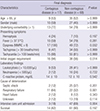1. Lozano R, Naghavi M, Foreman K, Lim S, Shibuya K, Aboyans V, Abraham J, Adair T, Aggarwal R, Ahn SY, et al. Global and regional mortality from 235 causes of death for 20 age groups in 1990 and 2010: a systematic analysis for the Global Burden of Disease Study 2010. Lancet. 2012; 380:2095–2128.
3. Tsang KW, Ho PL, Ooi GC, Yee WK, Wang T, Chan-Yeung M, Lam WK, Seto WH, Yam LY, Cheung TM, et al. A cluster of cases of severe acute respiratory syndrome in Hong Kong. N Engl J Med. 2003; 348:1977–1985.
4. Ksiazek TG, Erdman D, Goldsmith CS, Zaki SR, Peret T, Emery S, Tong S, Urbani C, Comer JA, Lim W, et al. A novel coronavirus associated with severe acute respiratory syndrome. N Engl J Med. 2003; 348:1953–1966.
5. Cho SY, Kang JM, Ha YE, Park GE, Lee JY, Ko JH, Lee JY, Kim JM, Kang CI, Jo IJ, et al. MERS-CoV outbreak following a single patient exposure in an emergency room in South Korea: an epidemiological outbreak study. Lancet. 2016; 388:994–1001.
6. Lee A, Cho J. The impact of epidemics on labor market: identifying victims of the Middle East Respiratory Syndrome in the Korean labor market. Int J Equity Health. 2016; 15:196.
7. Knott JC, Tan SL, Street AC, Bailey M, Cameron P. Febrile adults presenting to the emergency department: outcomes and markers of serious illness. Emerg Med J. 2004; 21:170–174.
8. Puro V, Fusco FM, Lanini S, Nisii C, Ippolito G. Risk management of febrile respiratory illness in emergency departments. New Microbiol. 2008; 31:165–173.
9. Knibbs LD, Morawska L, Bell SC, Grzybowski P. Room ventilation and the risk of airborne infection transmission in 3 health care settings within a large teaching hospital. Am J Infect Control. 2011; 39:866–872.
10. Fusco FM, Schilling S, De Iaco G, Brodt HR, Brouqui P, Maltezou HC, Bannister B, Gottschalk R, Thomson G, Puro V, et al. Infection control management of patients with suspected highly infectious diseases in emergency departments: data from a survey in 41 facilities in 14 European countries. BMC Infect Dis. 2012; 12:27.
11. Crenshaw LA, Lindsell CJ, Storrow AB, Lyons MS. An evaluation of emergency physician selection of observation unit patients. Am J Emerg Med. 2006; 24:271–279.
12. Oh MD, Choe PG, Oh HS, Park WB, Lee SM, Park J, Lee SK, Song JS, Kim NJ. Middle East Respiratory Syndrome Coronavirus superspreading event involving 81 persons, Korea 2015. J Korean Med Sci. 2015; 30:1701–1705.
13. Kang CK, Song KH, Choe PG, Park WB, Bang JH, Kim ES, Park SW, Kim HB, Kim NJ, Cho SI, et al. Clinical and epidemiologic characteristics of spreaders of Middle East Respiratory Syndrome Coronavirus during the 2015 outbreak in Korea. J Korean Med Sci. 2017; 32(9):–. 744–749.
14. Kim KH, Tandi TE, Choi JW, Moon JM, Kim MS. Middle East Respiratory Syndrome Coronavirus (MERS-CoV) outbreak in South Korea, 2015: epidemiology, characteristics and public health implications. J Hosp Infect. 2017; 95:207–213.
15. Liang SY, Theodoro DL, Schuur JD, Marschall J. Infection prevention in the emergency department. Ann Emerg Med. 2014; 64:299–313.
16. Hasegawa K, Tsugawa Y, Cohen A, Camargo CA Jr. Infectious disease-related emergency department visits among children in the US. Pediatr Infect Dis J. 2015; 34:681–685.
17. Rodriguez-Noriega E, Gonzalez-Diaz E, Morfin-Otero R, Gomez-Abundis GF, Briseño-Ramirez J, Perez-Gomez HR, Lopez-Gatell H, Alpuche-Aranda CM, Ramírez E, López I, et al. Hospital triage system for adult patients using an influenza-like illness scoring system during the 2009 pandemic--Mexico. PLoS One. 2010; 5:e10658.
18. Varughese S, Read JG, Al-Khal A, Abo Salah S, El Deeb Y, Cameron PA. Effectiveness of the Middle East Respiratory Syndrome-coronavirus protocol in enhancing the function of an Emergency Department in Qatar. Eur J Emerg Med. 2015; 22:316–320.
19. Anathallee M, Curphey A, Beeching N, Carley S, Crawford I, Mackway-Jones K. Emergency departments (EDs) in the United Kingdom (UK) are not prepared for emerging biological threats and bioterrorism. J Infect. 2007; 54:12–17.
20. Schilling S, Fusco FM, De Iaco G, Bannister B, Maltezou HC, Carson G, Gottschalk R, Brodt HR, Brouqui P, Puro V, et al. Isolation facilities for highly infectious diseases in Europe--a cross-sectional analysis in 16 countries. PLoS One. 2014; 9:e100401.











 PDF
PDF ePub
ePub Citation
Citation Print
Print




 XML Download
XML Download